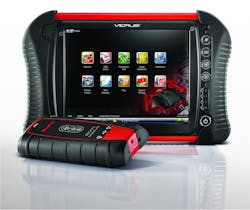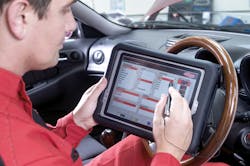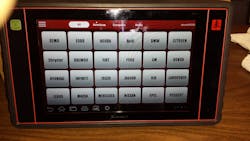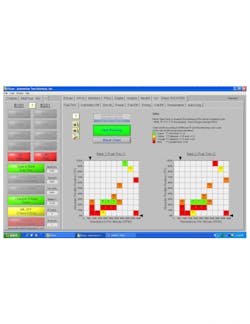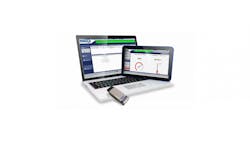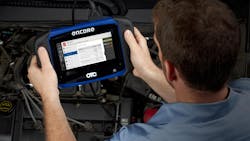Mastering Your Scan Tool
In order to master a scan tool, you need to understand that there is much more to it than reading codes. It’s the ability of interpreting the Parameter Identifier (PID) data displayed on the screen that will lead you to a successful diagnosis and repair of the vehicle. Knowing a good scan tool PID from a bad one makes all the difference in a proper diagnosis.
Remember that Diagnostic Trouble Codes (DTCs) are not set for everything. You can have a thermostat, for example, that does not reach the proper temperature in the specified amount of time, preventing the vehicle from completing monitors, shifting right or running correctly. Just because the vehicle produces heat does not mean that the thermostat is functioning correctly. Another example could be a Barometric Pressure (BARO) sensor that is out of calibration causing a drivability problem but is not bad enough to set a DTC.
My objective in writing this article is to help you get the most out of your scan tool. I will provide some highlights of some common scan tools that are used in America’s service bays. I am not going to cover OE scan tools in this article, because the majority of shops are using aftermarket tools. I will cover different tools in order to provide you with some of their best features. This will help you utilize them more effectively to capture the most information in the least amount of time.
Using the Scan Tool for Drivability Problems
Before we go too deep, let’s get the caveats out of the way. When it comes to diagnosing engine performance, DTCs or drivability problems, use the Generic/Global functionality of your scan tool to expedite the diagnosis. Generic/Global OBDII allows us to view information quickly while allowing access to pending DTCs, monitor status, Mode $06 data, Freeze Frame records and a lot more. You won’t get all that information in the Enhanced side of your scan tool, so start with the Generic/Global side first. If you need more data PIDs or bi-directional control, switch to the Enhanced side. Also, Generic/Global PIDs are the same on every vehicle, whether it’s a GM or a Porsche, and are easy to understand.
It’s always helpful to know and understand all aspects of your scan tool along with the vehicle systems that you are working on before diving into a problem vehicle. There is nothing worse than going in blind — not understanding or utilizing the functions of the scan tool or knowing how the vehicle system operates. A good understanding of both will allow us to diagnosis and repair the system we are working on.
It’s setting up a game plan that is going to save you time in diagnosing the problem. Knowing where to start, such as what scan tool to use on the problem vehicle along with knowing where to find the correct information for the vehicle is the key to success. We all have wasted time in diagnosing a problem vehicle whether it was using a scan tool that could not provide the information we needed to view or allow us the bidirectional control to activate a component we needed to test. Some shops decide to purchase a second scan tool out of frustration of not being able to diagnosis a problem vehicle. Let’s face it — you need the right tools in order to perform the correct diagnosis.
Because some scan tools work better than others on different vehicle lines, another scan tool might be the correct option to invest in if you haven’t already done so. A good example is when a Mercedes-Benz rolls into my shop. I know what scan tool I am going to connect to the vehicle. I don’t want to connect a scan tool that is going to provide only a partial list of information, limiting my ability to repair the vehicle. The scan tool that I will connect to the Benz is Autologic, because it has the proper software displaying engine to body data and everything in between including bi-directional control, module coding and the ability to reprogram modules.
I understand that not everyone reading this article has the variety of scan tools that I have, but you might be thinking about which one to purchase to fill the hole. Some of you may not work on every vehicle line that’s on the road; maybe you just work on domestic, Asian, European or even one vehicle from that selection such as BMW or Toyota. There are many specialty shops in the country that focus on just one vehicle brand, making their selection of a scan tool easier and less expensive in most cases. Most scan tools today provide a full system scan that queries all of the vehicle’s control modules (ECUs) to see if any contain system faults. Sometimes a fault in one system can affect another system.
For example, our shop once had a Dodge Dakota with a complaint of a hard shift into first gear. The shifting problem turned out to be caused by a PO136 (O2 Sensor Bank 1 Sensor 2 heater malfunction). After Wayne Colonna (transmission expert, ATSG president and publisher of Motor Age’s POWERTRAIN Pro) turned us on to the correct diagnostic path, we found the connection between the O2 heater to the shifting problem along with help from the OTC all system scan.
To be successful using a scan tool, you need to connect it to a bunch of vehicles and see what good data looks like so you can identify bad data. For instance, you should check short term fuel trim (STFT) and long term fuel trim (LTFT), engine temperature, BARO, calculated load, rpm, MAP or MAF and the O2/AF sensors on every vehicle you test. You always should start your diagnosis by using the Generic/Global section on your scan tool even if you have the factory level scan data available. The reason is that Generic/Global OBDII PID data is limited to a select number of the most important data PIDS that the Engine Control Module (ECM) can provide for emissions and driveability related failures in OBDII.
Remember that Generic/Global PIDS are the same on every vehicle, so whether it’s a Ford or a Subaru, the data PIDs all are the same and not confusing to understand. Another important reason is that Generic/Global will not substitute a PID value as Enhanced data often will. Of course, as you can expect in the automotive field, there is an exception, which concerns the Air Fuel Ratio/Wide Range sensors. Some scan tools will display a Toyota AF sensor voltage at approximately 0.685 volt, when in reality it’s at 3.3 volts in the Enhanced side of the scan tool.
The best way to master scan tool data is to connect a Generic/Global scan tool to known good vehicles and record the data. Remember that there is much less data to deal with and decipher in Generic mode. Start by checking the following PIDs and make it a habit on every vehicle that comes in for you to diagnosis: barometric pressure (BARO), calculated load (CALC LOAD), engine temperature (TEMP), long-term fuel trim (LTFT), short-term fuel trim (STFT), manifold absolute pressure (MAP) or mass air flow (MAF), O2/air fuel sensors (HO2SxBx), and RPM for starters.
When diagnosing an illuminated malfunction indicator lamp (MIL), do not erase the DTCs unless the original equipment manufacturer (OEM) states in its service information to do so or you will reset all monitor statuses to “Not Ready.” When vehicle monitors are Not Ready, it will be difficult to tell if you really solved the problem. When monitors are “Ready,” the vehicle’s ECM will be checking for parameters that are out of range and will record the failure as a pending code or turn on the MIL. On many newer vehicles (2010 and up), you most likely won’t have to erase the DTC; they will clear on their own if the right conditions are met. The ECM will check for three consecutive passes in the failing system and turn the MIL off on it’s own.
In the case of permanent DTCs, it’s the only way to clear the code. If you do erase the DTCs at the start of your diagnosis, it’s like using bleach on a crime scene erasing all the evidence. It makes no sense to clear anything from the ECM without printing, screen capturing, or writing down all the PID information along with the mature DTCs, Freeze Frame records, Pending DTCs, Mode $06 data and monitor status. Using the information on when and what speed, temperature, load, etc., is very important in diagnosing the problem.
Scan Tools
One Generic/Global OBDII scan tool to use when performing drivability diagnostics is the EScan scan tool from Automotive Test Solutions. The tool makes scanning easy along with providing a wealth of information at your fingertips. In addition to the standardized OBDII PIDs, the EScan also provides some very helpful diagnostic information in the left panel. The EScan has eight other tabs on the upper part of the screen that offer even more options, including its exclusive “Sharp Shooter” section.
In this section there are additional tabs that allow the user to take an in-depth look at Fuel Trim, Volumetric Efficiency, Simulated Injector, Power, Fuel Efficiency, Timing, Catalytic Efficiency, Time to Temperature/thermostat time and Auto Diagnosis* (*this will be completed in the near future providing a comprehensive report on the vehicle being tested). The EScan does not have Enhanced data or bi-directional control, except for Mode $08 that allows the EVAP vent solenoid to be commanded closed.
The Autoenginuity PC-based scan tool is another option for technicians on a budget. Users can start out with a basic Global OBDII tool, or add one of the 48 different car lines the company supports for enhanced data. Enhanced offerings are also bundled to make growing the tool’s capabilities easy. In addition, a J2534 Vehicle Communication Interface is available for use with the scan tool software or as a standalone reprogramming tool.
The OTC Encore™ is a mini-tablet scan tool that uses the Android operating system. Like many new tablet-based tools using this operating system, it boots up quickly and is ready to go in just a few seconds. The tool provides for Global OBDII information including decoded Mode $06 information and also offers Enhanced options for domestic, Asian and European vehicles (a feature common to most tools) as well as the ability to perform a complete system scan (another increasingly common feature).
The tool also provides a variety of diagnostic aids including Identifix Quick Fixes, Pathfinder, BOB (break out box) pin locations and other helpful information. The tool is updated via the Internet. OTC also offers the Genisys Touch™ tablet that has all the same functions but includes a J2534-1/-2 compliant Vehicle Communications Interface (VCI) that can be used for reprogramming. There also is the option of adding on a two-channel labscope, adding more diagnostic power to one tool. This Windows-based unit speeds up your diagnosis by allowing you to connect to helpful technical websites such as iATN, Identifix, Alldata and TST. It also has a library of embedded training videos you can access right from the tool.
The Snap-On VERUS® is another Windows-based PC tablet that provides many of the same features other high-end scan tools offer. The Mode $06 function of the scan tool with v14.2 and up software decodes many of the Mode $06 data. The scan tool performs bi-directional control, codes modules and performs relearn procedures. The unit also has the ability to function as a four-channel labscope along with the built-in aids to help you with connections and pin locations, making it easier to incorporate labscope testing in your routine.
For even more diagnostic help, there is Snap-on’s FastTrack® Troubleshooter diagnostic database and Guided Component Testing information.
The Launch X-431 Android-based tablet is a very capable scan tool that uses a Class 1 Bluetooth connector and has the ability to search Google for DTC information. It also has a built-in vehicle maintenance and repair database along with the ability to update the scan tool via the Internet. The tool can graph 15 data PIDs at once, code modules, perform bi-directional control and perform relearns while performing very fast.
Delphi’s AutoIQ scan tool can be purchased as a software addition to your own PC or as a PC-based tablet. It uses a VCI to connect to the vehicle, providing reprogramming capabilities in addition to solid OE-level Enhanced coverage. One feature is the Health Check of all onboard modules that can complete a total system check in only a few seconds. The tool has deep coverage that performs OE level functions very well. When I used the tool on a new GM vehicle, I thought that I was using the factory scan tool.
Another good test was when I used it on a 2009 Subaru and found very good data, bi-directional functions and module coverage. The scan tool connected very quickly without a problem while performing a complete module scan and I have to report that was very impressive.
Autologic is for the serious shop that wants complete coverage for European vehicles. This scan tool graphs, saves screens, logs files, codes and reprograms. This is one of the few scan tools that I use that does not let me down when diagnosing a vehicle. It’s easy to use on every function, while being capable of reprograming with ease. The tool also comes with live tech support that is helpful to a tech working on a problem vehicle.
Autoland Scientech iScan II WT is another good scan tool that has excellent coverage for European, Asian and now domestic vehicles. It has most of the features I described on the other scan tools along with a very strong bi-directional and coding function. With a recent download via the Internet, the tool now is able to perform BMW offline programming on many models, with more coming in the future. The tool can also be used as an interface with factory software such as Audi/VW, BMW, Ford, Jaguar, Mazda, Mercedes Benz, Range Rover, Toyota and Volvo. To connect to this software, you will need the optional laptop that has the software load on it. In some cases, using the laptop software also provides for reprogramming when available.
There is a new scan tool worth mentioning. MAHLE recently introduced a tablet-based scan tool. While I was at APPEX 2014, I saw the tool in action and was impressed with the speed and functions of the tool. The tool is scheduled for release later this year, providing at first domestic and Asian coverage, and adding European coverage by 2016. The scan tool performs a complete module scan, provides decoded Mode $06 data with constant refresh, graphs, has bi-directional control, full data recording that can fill your hard drive, coding but does not support programming yet. The tool also comes with remote customer support.
This listing of scan tools is by no means complete. There are others offering a wide range of features and coverage. Which one is right for you is a decision based on your individual needs and the vehicles you typically service.

